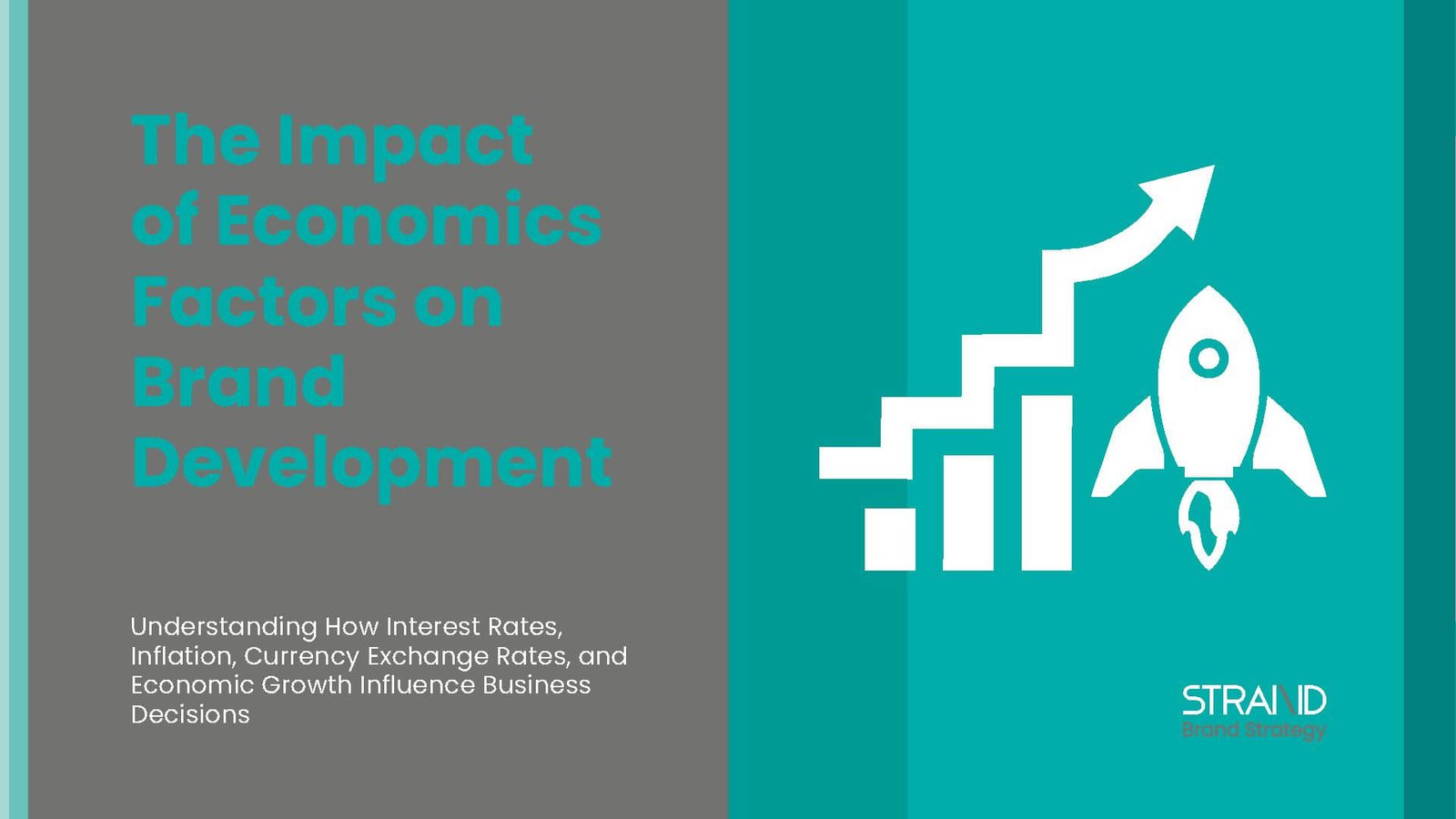The Impact of Economic Factors on Brand Development
9 minutes | 07 Oct 2024Understanding How Interest Rates, Inflation, Currency Exchange Rates, and Economic Growth Influence Business Decisions
In today’s global economy, businesses and brands are deeply intertwined with a range of economic factors that influence their success and sustainability. From interest rates and inflation to consumer spending power and unemployment rates, these economic variables shape the landscape in which companies operate. Understanding these factors is not only essential for day-to-day decision-making but also critical for long-term brand strategy and growth.
Economic conditions directly impact purchasing power, market demand, and operational costs. Brands that stay aware of the broader economic environment make more informed decisions, manage costs effectively, set pricing strategies, and plan for expansion. In this article, we will explore how various economic factors—interest rates, inflation, currency exchange rates, and more—affect business strategy. We will also discuss how brands can adapt to changing economic conditions to maintain competitive advantage and long-term growth.
Section I: Economic Factors and Their Impact on Business
Economic factors refer to the external conditions that affect the performance and decision-making of businesses. These include interest rates, inflation, unemployment rates, currency exchange rates, economic growth, and consumer spending power. Each of these elements can influence market conditions, operational costs, pricing strategies, and overall profitability.
Current Trends:
The global economy is subject to a continuous ebb and flow of economic factors, with certain trends impacting business and consumer behavior. For instance, in recent years, the world has experienced fluctuating interest rates, inflationary pressures, and shifting currency exchange rates, all of which have significant implications for companies, particularly those operating in multiple markets.
Inflation is currently a critical concern for businesses worldwide. Rising inflation rates lead to increased costs of goods and services, which affect pricing strategies and profit margins. Meanwhile, interest rate changes, typically influenced by central banks such as the Federal Reserve or the European Central Bank, have a profound effect on the cost of borrowing, which in turn affects capital investments and expansion plans.
Another trend is the volatility of currency exchange rates, driven by geopolitical instability and fluctuations in global trade. Companies operating in international markets must pay close attention to these shifts, as currency fluctuations can impact revenue, costs, and profitability.
Implications:
For brands, these economic factors represent both risks and opportunities. A favorable economic environment—characterized by low inflation, low-interest rates, and stable currency exchange rates—creates an ideal condition for business growth. However, adverse economic conditions can increase operational costs, reduce consumer demand, and put pressure on profit margins.
In times of high inflation, for example, businesses may need to raise prices to cover rising costs, which could potentially alienate price-sensitive customers. Alternatively, during periods of low-interest rates, businesses may be incentivized to take on more debt to fund expansion, benefiting from lower borrowing costs.
Economic downturns, such as recessions, also force businesses to re-evaluate their strategies. During these periods, consumer spending power declines, and businesses must become more cost-conscious, often resorting to layoffs or cutting back on investments to maintain profitability.
Examples:
The retail sector provides clear examples of how economic factors shape business strategy. During the 2008 financial crisis, many retail brands faced declining sales as unemployment rates soared and consumer confidence plummeted. Brands like Walmart and Costco, which positioned themselves as value-oriented retailers, performed relatively well during this time, as consumers turned to more affordable shopping options. Conversely, luxury brands saw a significant dip in sales due to reduced discretionary spending.
In the tech industry, Apple has had to adjust its pricing strategies in response to currency fluctuations. In 2015, due to a strong U.S. dollar, Apple increased prices for its products in countries like Canada and Australia to offset losses from unfavorable exchange rates, demonstrating how conditions can directly affect pricing decisions.
Section II: Analysis of Key Economic Drivers Influencing Brand Strategy
Factors/Drivers:
- Interest Rates:
Interest rates, controlled by central banks, determine the cost of borrowing money. High-interest rates make loans more expensive, discouraging borrowing for expansion and capital investments. Conversely, lower interest rates reduce the cost of borrowing, encouraging businesses to invest in growth opportunities such as new product lines, international expansion, or technological upgrades. - Inflation:
Inflation refers to the rising costs of goods and services over time, which erodes the purchasing power of consumers. For businesses, inflation impacts the cost of raw materials, labor, and overhead, potentially leading to higher prices for consumers. Companies must carefully balance raising prices to protect profit margins while maintaining customer loyalty. - Currency Exchange Rates:
Currency exchange rates affect businesses that operate in multiple countries. A weak domestic currency makes exports more competitive abroad, while a strong domestic currency makes imports cheaper but can reduce profitability in international markets. Managing currency fluctuations is a critical aspect of international business strategy, especially for brands involved in global trade. - Economic Growth:
Economic growth is a measure of the increase in the production of goods and services in an economy over a period of time. Strong economic growth leads to higher consumer spending, creating opportunities for businesses to expand and increase sales. Conversely, slow or negative growth can lead to reduced demand and force businesses to implement cost-cutting measures. - Unemployment Rates:
High unemployment rates signal economic distress, reducing consumer spending power and confidence. On the other hand, low unemployment rates increase disposable income and stimulate demand for goods and services. Brands must monitor labor market trends to understand their customers’ ability and willingness to spend. - Consumer Spending Power:
Consumer spending power is influenced by a combination of wages, inflation, and interest rates. When consumers have more disposable income, they are more likely to spend on both essentials and discretionary items. Conversely, when conditions reduce spending power, businesses may see a shift in demand toward cheaper alternatives or a general reduction in sales.
Challenges/Opportunities:
Economic factors present both challenges and opportunities for businesses. High inflation, for example, forces companies to innovate to maintain margins without alienating customers with price hikes. Similarly, high-interest rates may discourage borrowing, but they also encourage brands to focus on optimizing internal resources rather than pursuing aggressive expansion.
Conversely, economic growth and low-interest rates offer opportunities for brands to expand and invest in new technologies, product development, and marketing initiatives. Companies that capitalize on these favorable conditions can gain market share and improve profitability.
Stakeholder Impact:
Economic factors influence a wide range of stakeholders. For shareholders, economic stability and growth can lead to higher returns on investment, while economic downturns may result in lower stock prices or reduced dividends. Employees are affected by economic conditions through job security, wage growth, and employment opportunities, especially during periods of economic expansion or contraction.
Customers are perhaps the most directly impacted by economic factors, as changes in interest rates, inflation, and employment influence their purchasing decisions. During tough economic times, customers may prioritize basic necessities over luxury or non-essential goods, forcing brands to adapt their product offerings and pricing strategies.
Section III: Solutions and Strategies for Navigating Economic Challenges
Proposed Solutions:
- Adapting Pricing Strategies:
In times of economic uncertainty, brands must carefully manage their pricing strategies to balance profitability and customer retention. One approach is to implement dynamic pricing, where prices are adjusted in real time based on changes in demand, competitor pricing, and economic conditions.
Additionally, businesses can introduce tiered pricing structures, offering both premium and budget-friendly product options. This allows companies to cater to both high-income and price-sensitive consumers, ensuring a diverse customer base during economic fluctuations. - Investing in Innovation and Efficiency:
Economic challenges often necessitate operational efficiencies. Investing in automation, digitization, and supply chain optimization can help businesses reduce costs and improve margins during periods of inflation or slow economic growth. Brands that innovate during downturns are better positioned to capture market share when conditions improve. - Diversifying Revenue Streams:
Economic uncertainty reinforces the importance of diversification. Brands should explore new revenue streams, whether through product diversification, entry into new markets, or leveraging digital platforms for e-commerce. By spreading risk across multiple income sources, businesses are better protected against downturns in any single market. - Building Strong Financial Resilience:
Brands must build financial resilience to weather storms. This includes maintaining healthy cash reserves, minimizing debt, and optimizing working capital. A strong financial foundation allows businesses to continue operations and invest in growth, even when external conditions are unfavorable. - Enhancing Customer Loyalty:
Retaining customers during economic downturns is crucial. Brands should prioritize customer engagement and loyalty programs to foster long-term relationships. Providing value through excellent customer service, personalized experiences, and rewards for repeat purchases can help brands maintain customer trust, even when disposable income is limited.
Case Studies:
During the COVID-19 pandemic, the fast-food giant McDonald’s adjusted its strategy to reflect economic challenges. By introducing value meals and offering more affordable options, McDonald’s managed to retain its customer base despite reduced consumer spending power. Similarly, Netflix thrived during the pandemic by maintaining affordable subscription rates and expanding its content offerings, catering to consumers looking for affordable entertainment during economic hardships.
Future Outlook:
As economic factors continue to fluctuate, businesses must adopt strategies that allow for agility and resilience. The future will likely see increased reliance on data analytics to forecast economic trends and inform decision-making. Companies that integrate real-time data insights into their operations will be better equipped to adapt to changes in consumer behavior, currency fluctuations, and interest rates.
Becoming an Economically Resilient Brand
In conclusion, businesses and brands must remain vigilant and adaptive to the influence of economic factors. Whether it’s managing the challenges posed by inflation and interest rates or capitalizing on opportunities during periods of economic growth, brands that understand and anticipate economic changes will be better positioned for long-term success.
By implementing pricing flexibility, investing in innovation, diversifying revenue streams, and building financial resilience, companies can navigate economic uncertainty and strengthen their market position. Furthermore, customer loyalty should remain a key focus for brands, as retaining a loyal customer base is essential during both prosperous and challenging economic times.

